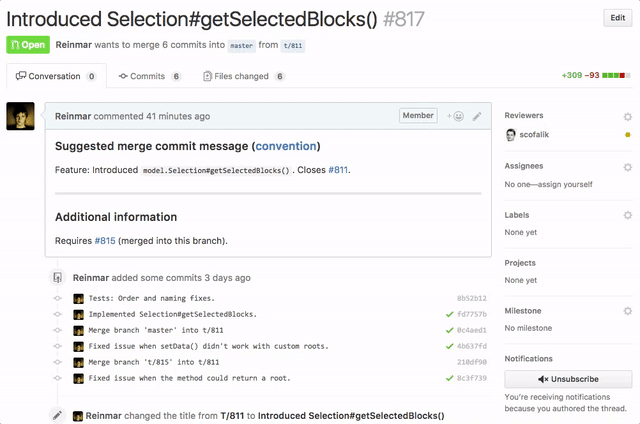 Git commit message convention
Git commit message convention
Every commit made directly to the master branch must follow the convention below. Based on commits in the master branch CKEditor 5 release tools will generate changelog entries for the current release.
Commits in the ticket branches are not analyzed for the changelog and do not have to follow any specific convention (other than finishing sentences with periods). In case of ticket branches, only merge commits are analyzed.
Therefore, this guide is mainly targeted at core team members. However, it may help you understand how to write a suggested commit message when creating a pull request for CKEditor 5.
# Convention
Commit message template:
Type (package-name): A short sentence about the commit. Closes #XXX.
Type (another-package-name): If the change affects more than one package, it's possible to put multiple entries at once. Closes #YYY.
Optional description.
BREAKING CHANGE: If any breaking changes were done, they need to be listed here.
BREAKING CHANGE: Another breaking change if needed. Closes #ZZZ.
# Commit types
| Type | Release | Description | Changelog |
|---|---|---|---|
| Feature | minor |
A new feature. | Visible |
| Fix | patch |
A bug fix. Should also be used for enhancements if they do not introduce new features at the same time. | Visible |
| Other | patch |
An enhancement — when it is neither a bug fix nor a feature. Example: public API refactoring. Use it also if you do not want to admit that it was a bug 😉. | Visible |
| Docs | patch |
Updated documentation. | Hidden |
| Internal | patch |
Other kinds of internal changes. | Hidden |
| Tests | patch |
Changes in test files. | Hidden |
| Revert | patch |
Revert of some commit. | Hidden |
| Release | patch |
A special type of commit used by the release tools. | Hidden |
Each commit can contain additional notes that will be inserted into the changelog:
MAJOR BREAKING CHANGE(alias:BREAKING CHANGE),MINOR BREAKING CHANGE.
If any change contains the MAJOR BREAKING CHANGE note, the next release will be marked as major automatically.
For reference on how to identify minor or major breaking change see the versioning policy guide.
# Package name
Most commits are related to one or more packages. Each affected package should be listed in parenthesis following the commit type. A package that was the most impacted by the change should be listed first.
It is, however, possible to skip this part if many packages are affected. This usually indicates a generic change. In this case having all the packages listed would reduce the changelog readability.
The package name is based on the npm package name, however, it has the @ckeditor/ckeditor(5)- prefix stripped.
If your change is related to the main package only, use ckeditor5 as the package name.
# Example commits
A new feature without any breaking changes.
Feature (ui): Added support for RTL languages. Closes #1.
RTL content will now be rendered correctly.
A generic bug fix for an existing feature that affects many packages (closes two tickets):
Fix: The editor will be great again. Closes #3. Closes #4.
A commit with updated documentation:
Docs (link): Updated the README.
A commit that provides or changes the tests:
Tests (widget): Introduced missing tests. Closes #5.
An improvement that is not backward compatible and sent by a non-core contributor. Public API was changed:
Other (utils): Extracted the `utils.foo()` to a separate package. Closes #9.
Feature (engine): Introduced the `engine.foo()` method. Closes #9.
MAJOR BREAKING CHANGE: The `utils.foo()` method was moved to the `engine` package. See #9.
For the commits shown above the changelog will look like this:
Changelog
=========
## [1.0.0](https://github.com/ckeditor/ckeditor5/compare/v1.0.0...v0.0.1) (2017-01-04)
### MAJOR BREAKING CHANGES [ℹ️](https://ckeditor.com/docs/ckeditor5/latest/framework/guides/support/versioning-policy.html#major-and-minor-breaking-changes)
* The `utils.foo()` method was moved to the `engine` package. See #9. See [#9](https://github.com/ckeditor/ckeditor5/issue/9).
### Features
* **[engine](http://npmjs.com/package/@ckeditor/ckeditor5-engine)**: Introduced the `engine.foo()` method. Thanks to [@CKEditor](https://github.com/CKEditor). Closes [#9](https://github.com/ckeditor/ckeditor5/issue/9). ([e8cc04f](https://github.com/ckeditor/ckeditor5/commit/e8cc04f))
* **[ui](http://npmjs.com/package/@ckeditor/ckeditor5-ui)**: Added support for RTL languages. Closes [#1](https://github.com/ckeditor/ckeditor5/issue/1). ([adc59ed](https://github.com/ckeditor/ckeditor5/commit/adc59ed))
RTL content will now be rendered correctly.
### Bug fixes
* The editor will be great again. Closes [#3](https://github.com/ckeditor/ckeditor5/issue/3). Closes [#4](https://github.com/ckeditor/ckeditor5/issue/4). ([a0b4ce8](https://github.com/ckeditor/ckeditor5/commit/a0b4ce8))
### Other changes
* **[utils](http://npmjs.com/package/@ckeditor/ckeditor5-utils)**: Extracted the `utils.foo()` to a separate package. Thanks to [@CKEditor](https://github.com/CKEditor). ([e8cc04f](https://github.com/ckeditor/ckeditor5/commit/e8cc04f))
# Handling pull requests
When creating a pull request, its author may (it is recommended in the pull request template) propose a merge commit message.
The reviewer’s duty is to validate the proposed message and apply necessary changes. The PR description can be edited.
Things like:
- language and grammar of the message,
- type of the change,
- mentioned issue(s) number,
- breaking changes,
- and any additional information
should be checked and added if missing.
As a reviewer, remember that the message will end up in the changelog and must be understandable in a broad context of the entire editor. It is not for you — it is for other developers.
When closing a PR, remember to copy the source of the message to the textarea with the merge commit message:

# Giving credit
When closing a non-core contributor’s PR make sure to add information about the contributor to the commit message. For example:
Feature (ui): Added support for RTL languages. Closes #1.
Thanks to @someone!

